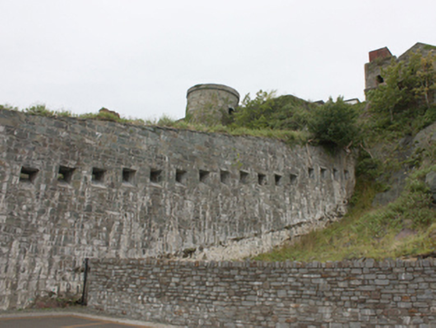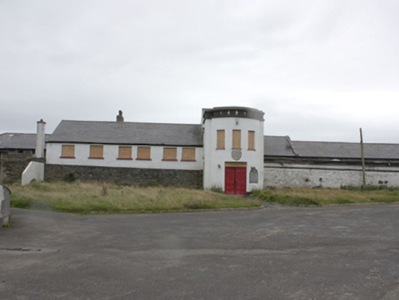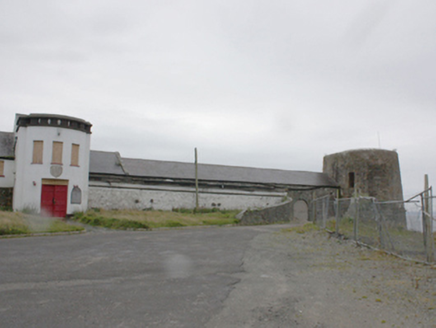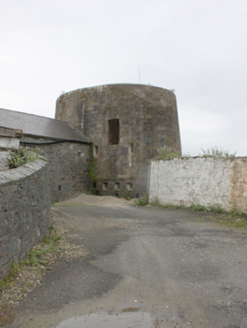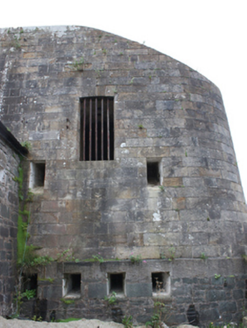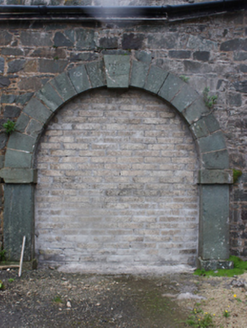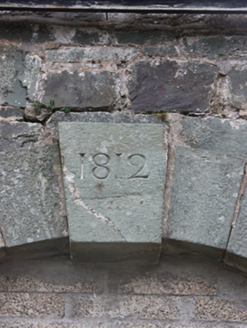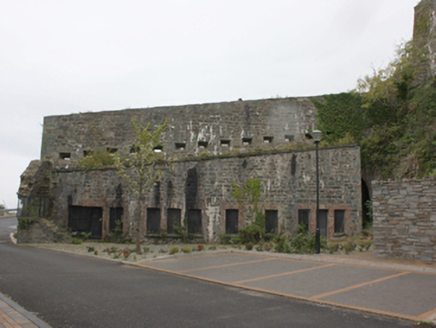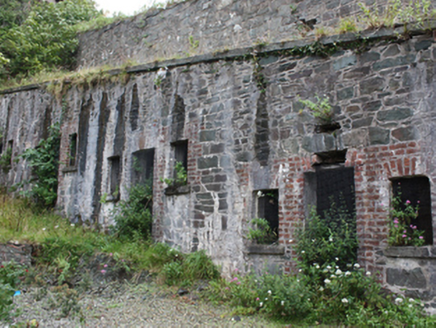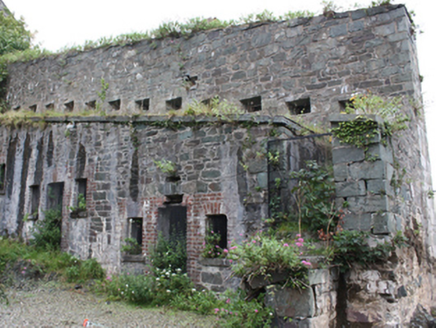Survey Data
Reg No
40810007
Rating
Regional
Categories of Special Interest
Architectural, Historical, Technical
Original Use
Barracks
Historical Use
Museum/gallery
Date
1800 - 1820
Coordinates
265416, 440324
Date Recorded
18/09/2008
Date Updated
--/--/--
Description
Freestanding multiple-bay defensive battery on complex irregular-plan, built 1811-14, comprising two-storey tower (on ovoid-plan) having tapered walls and with mountings for two guns to platform over, multiple-bay two-storey barracks buildings arranged around a courtyard to the north, lower courtyard to the south having former battery with flanking walls to the east and west with gun loop openings, and with sunken magazine to the centre of yard with earthen mound over. Main entrance to the south-west corner through integral round-headed carriage-arch, now blocked. Later in use as a hotel and visitor centre, now disused. Roof of corbelled ashlar limestone with inset cast-iron pivots and runners, ashlar sandstone parapet with sloped coping and segmental arched recesses. Pitched natural slate and flat felted roofs to former barracks with ashlar gable copings, skew blocks and cut stone eaves course. Battered ashlar sandstone walls to tower; painted roughcast rendered rubble stone walls to barracks and ancillary structures. Rubble stone defensive walls with gun loops to parapets and circular stair tower between upper and lower courtyard levels. Magazine to centre of yard. Timber fixed-pane window with stone reveals internally with brick elliptical vault with ‘murder hole’ over; timber sliding sash windows to barracks. Round-headed carriage-arch to the south-west, now blocked, having ashlar surround with projecting keystone dated ‘1812’. Set within own grounds on an elevated site overlooking Lough Foyle to the south. Located to the east end of Greencastle with remains of former fourteenth century Northburg Castle (see RMP DDG022-003----) adjacent to the south-west. Former defensive glacis to the north.
Appraisal
This impressive Napoleonic-era coastal fortification is an important element of the built heritage and history of County Donegal. Despite some modifications over the years to accommodate new uses, and recent works to create a museum and hotel, it retains much of its stark and imposing early character and form, and much of its salient fabric. It is now out of use. The present fort may have replaced an earlier temporary earthen battery at this site, which was one of a number established by the British after 1798 and the continuing threat of French invasion (there was an attempted landing in Lough Swilly by the French in 1798 with a force of some 8,000 men, which was repelled at sea). It was constructed following the recommendations of the Gother Mann committee, established in 1804 to review Ireland's coastal defences, and the site here at Greencastle was one of five sites selected by a Captain Sir William Smith in 1810 as the locations for new ‘permanent’ coastal batteries defending Lough Swilly and Lough Foyle. Greencastle was of high strategic interest as it controlled the entrance to Lough Foyle and the city of Derry, and the presence of the now ruinous fourteenth century Northburg Castle (see RMP DDG022-003----) adjacent to the south west is testament to the long observed strategic importance of this site. The other sites selected for permanent batteries in 1810 were at Muckamish, Knockalla, Rathmullan, and at Ned’s Point near Buncrana. It is similar in plan to those on Inch Island (see 40903705) and at Knockalla (see 40901801) with tower guarding one angle and defensive curtain walls radiating down to the water’s edge, and with battery located adjacent to the coast guarded by high retaining wall and parapet. There were originally five 24-pounder guns on traversing platforms to the top of the battery. The distinctive battered tower to the south-west corner formerly had two 5½ -inch howitzers to the roof, c. 1817. To the north of the battery is a sunken magazine with large earthen mound over, which was constructed to protect the magazine from being hit in case of artillery attack. The barracks buildings to the upper yard to the north end of the fort were originally built to accommodate three officers and fifty-four men. Construction at Greencastle probably started in 1811 but soon ran into difficulties as the main contractor, Edward Farrell, had financial problems, having tendered at about £6,000 for a project estimated at £11,000. The fort was not completed and the guns were not in place in 1814 when Sir Walter Scott visited the site. However, a master gunner, George Davidson, was appointed here in October 1813. By the time it was completed c. 1816, the threat of a feared French invasion had passed following Napoleon’s defeat at Waterloo the year before. It is unlikely that anything near the full compliment of personal as the fort was originally designed for were ever stationed here. The fort was re-armed in 1860 following a review by the Defence Committee with the installation of one smooth bore 10-inch gin and four smooth bore 68-pounders in the lower battery, and with two 68-pounders in the upper fort (probably on the tower). The fort had a detachment of two officers and thirty men in 1868, and in 1874 the fort had one 10-pounder gun, four 68-pounders, and two 5½ -inch howitzers. £200 was spent on alterations at Greencastle in 1884 (unknown). The fort at Greencastle continued to be garrisoned until 1890, when the gunners left the fort. This former battery complex forms part of a site that together constitute one of a number of coastal batteries built by the British military around Lough Swilly and Lough Foyle, and is of high historic importance to the Irish nation, shedding light on the strategic value of Lough Foyle during the nineteenth century. Furthermore, the site provides insight into the defensive thinking of military planners and the skills of military engineers at the time of construction, and is an integral element of the built heritage and social history of Inishowen.
